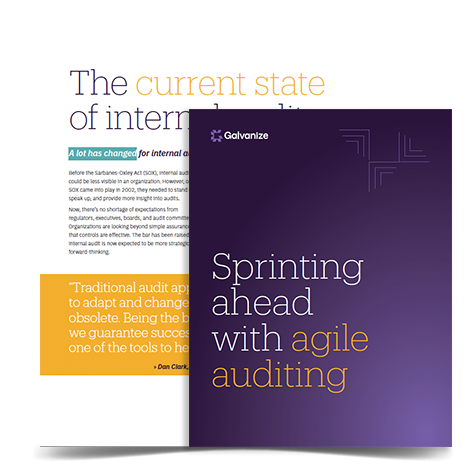The global COVID-19 pandemic is driving internal auditors to be more forward-thinking and strategic, and has certainly accelerated their need for speed. If you’re not there already, it might be time for your internal audit function to go agile.
We hear the word “agile” a lot these days, from aligning remote teams to managing cybersecurity risk. And certain things demand more agility, like shifting day-to-day COVID-19 challenges and revised business continuity plans. But, at the same time, internal auditors are getting way more pressure to move faster to help organizations manage emerging risks.
And internal audit functions are paying close attention to these new risks. A Galvanize survey on audit’s impact in a time of crisis found that 74% of internal audit teams were updating their audit plans to address COVID-19 risks.
As teams update their audit planning on the fly, adopting an agile methodology could help them take a more strategic and calculated approach. Agile methodology has its roots in software development, but has since been embraced by many industries and business functions, including internal audit. Instead of the longer, single-phase planning of a traditional audit, the agile audit process is centered around iterative, flexible planning in “sprints” (short bursts of planning, work, and increased collaboration).
We’ll explore ways to transition to agile auditing, but first, let’s look at some of the challenges that internal audit teams are facing in the wake of COVID-19.
“Traditional audit approaches and failing to adapt and change will make audit teams obsolete.” – Dan Clark, an internal auditor with over 30 years of experience
Compound challenges for internal auditors
The pandemic has forced teams to work remotely. It has introduced emerging risks, and interrupted onsite audits. It has stopped internal auditors from providing organizations with support and guidance—which is a big job even when there isn’t a global crisis!
Even before the pandemic began, audit teams would continuously strive to do everything quicker and more efficiently, usually without enough resources. And according to those survey results, about a third of internal audit functions have experienced budget cuts as a result of COVID-19. And around a quarter are dealing with reduced staffing. So now, more than ever, auditors need to literally do more with less.
Here are two other obstacles:
1. Communication challenges
Not surprisingly, some of the main issues that self-isolating auditors face involve communication. Staying connected to coworkers and stakeholders while working 100% remotely isn’t easy. And because auditors can’t necessarily perform physical audits at the moment, they need to rely on technologies like live video feeds of client inventory locations, or photos of evidence. We share more of these challenges and ways technology can help keep audits on track in an earlier blog.
2. High assurance expectations
Organizations are always—but especially now—looking to internal audit teams to provide real-time assurance. There is increased pressure as internal audit now has to address emerging risks like:
- Supply chain disruptions. According to an Institute for Supply Management survey on the impacts of COVID-19 on global supply chains, almost 75% of companies have experienced disruptions. Does your organization have enough resources to continue to operate sufficiently? Are there new third-party risks being added to the mix?
- The impact on human capital. From mental health programs to suspended hiring during COVID-19, what’s happening with the people in your workplace? Who’s managing which programs? How effective are these programs?
- Cybersecurity risks. A crisis like COVID-19 introduces a myriad of potential cyber risks. As more people work remotely, are their devices secure? How is the organization monitoring the security of collaborative cloud-based tools and user access?
- Financial statements. The pandemic has seriously disrupted accounting. How will government fiscal support or cash flow forecasts affect audits, for example?
To properly support the organization, internal audit needs to assess management’s awareness of all indirect and direct COVID-19 risks. In such a fast-moving, fluid environment, audit teams will be lagging behind if they strictly adhere to more traditional audit planning.
With agile audit, insights are realized more quickly, feedback is faster, and teams can incorporate findings right away.
How agile auditing makes it easier
While an agile audit methodology offers many advantages (which we outline in this eBook), we’ve chosen three of the most timely to share here:
1. Enhanced communication
With an agile audit approach, communication is more frequent and informal, with regular check-ins and sprints. These pulse checks are beneficial to remote teams and key stakeholders, who are in danger of becoming siloed. Virtual stand-up meetings are short and help teams quickly understand what was accomplished yesterday, what will be accomplished today, and what might get in the way of progress.
2. Rapid recognition of emerging risk
Because agile audit relies a lot on data analysis, the establishment of risk indicators and trend analysis will alert the audit team to emerging trends that can be either positive or negative. Reacting to those trends as they start to emerge can mitigate significant impacts much earlier than in traditional auditing techniques.
3. Real-time assurance
Because you’re working with accelerated delivery cycles, you can reassess your work every two to three weeks. This means that results and insights are realized more quickly and feedback is faster. Teams can immediately incorporate their findings into ongoing development phases.
If the idea to implement an agile auditing methodology seems daunting, especially right now, don’t worry. It’s important to understand that agile auditing isn’t an all-or-nothing approach. It’s totally fine to start small, and to still use traditional auditing methods where and when necessary.
5 ways to start transitioning to agile auditing
- Self-assess your own processes to see where and how to tailor agile for fit. Also, self-assess your current staff and determine their adaptability. Is your internal audit team ready for agile audit at this time?
- Get management buy-in. A good place to start can be sharing a roadmap that illustrates how an agile approach will add value. Like we mentioned above, rather than go “all in,” start with a trial or pilot to evaluate and update as needed.
- School your staff, whether it’s bringing in a seasoned agile audit team or working with an agile coach. There will be a learning curve!
- Stock your toolbox with online project management and collaboration tools. For example, AuditBond can make your transition smoother with automated workflows, standardized templates, a built-in audit trail, and real-time reporting.
- Read more to further understand the agile audit methodology, starting with our eBook.
The COVID-19 pandemic has led to serious health and financial consequences around the world. It has disrupted our sense of normalcy and everyday routines, including the ways we work and communicate. But it has also made agile organizations more proactive and resilient. As these organizations start to focus more closely on their COVID-19 recovery plans, the more nimble all teams—including internal audit—are, the better.
eBook:
Sprinting ahead with agile auditing
Explore the benefits, challenges, and best ways to implement agile audit. Learn:
- Why you should consider adopting an agile approach in audit
- How to overcome common transition challenges
- 10 steps to get started with agile auditing










